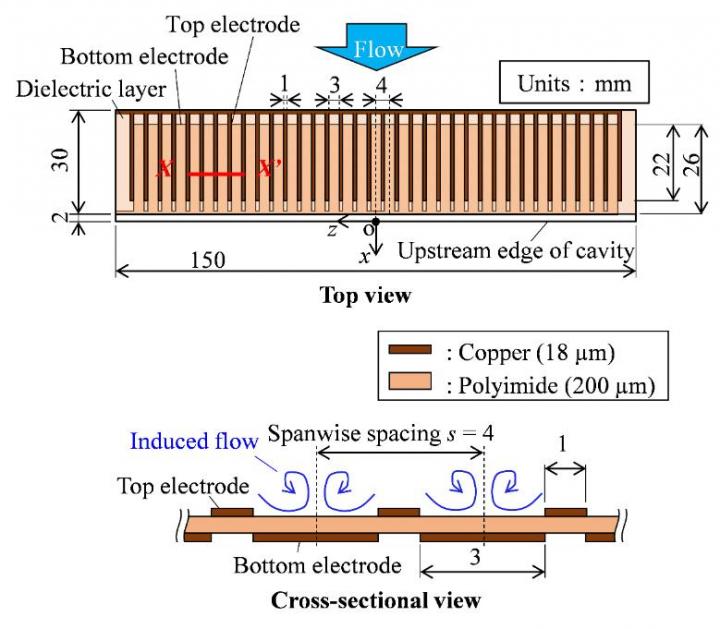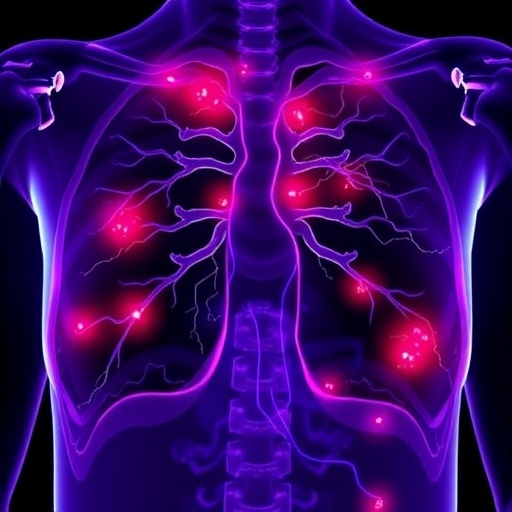
Credit: COPYRIGHT (C) TOYOHASHI UNIVERSITY OF TECHNOLOGY. ALL RIGHTS RESERVED.
Overview:
A research team in the Department of Mechanical Engineering at Toyohashi University of Technology developed a method for reducing aerodynamic noise via plasma. Cavity flow, such as the flow around car gaps of high-speed trains, often radiates aerodynamic noise. A plasma actuator inducing flow was applied to suppress this noise. By periodically switching off the power of the plasma actuator, a higher reduction in sound pressure level was observed when compared with continuous operation under the same power consumption.
Details:
A research team in the Department of Mechanical Engineering at Toyohashi University of Technology has developed a method for reducing aerodynamic noise via plasma generation in air. The flow over a hole or concave shape is termed as cavity flow, where aerodynamic noise is often radiated. The plasma actuator is a device that can induce various flows in air via plasma generation. Thus, a plasma actuator was applied to suppress this noise. The team demonstrated a reduction in aerodynamic noise by a maximum of 35 dB. Furthermore, the periodic switching off of the plasma actuator at an appropriate frequency led to a higher reduction in sound levels when compared with the continuous operation of the plasma actuator under the same power consumption. The results of their research were published in Physics of Fluids on October 9, 2020.
The aerodynamic sound often radiates from a cavity flow, such as the flow around the car gaps of high-speed trains and landing gear configurations of aircraft. Given that this noise is uncomfortable for passengers, it is necessary to reduce this noise. Recently, a flow-induced device consisting of top and bottom electrodes and a dielectric layer between them, termed as plasma actuator, has been utilized for flow control.
A research team in the Department of Mechanical Engineering at Toyohashi University of Technology demonstrated that the plasma actuator successfully weakened vortices that can cause intense levels of sound. Thus, the aerodynamic noise from the cavity flow was reduced, and the maximum reduction in sound level corresponded to 35 dB. Furthermore, to reduce the power required for driving the plasma actuator, the plasma actuator was periodically switched off. This type of driving is termed as “intermittent control.” Intermittent control at an appropriate frequency leads to higher sound reduction when compared with the continuous control under the same power consumption. The simulations of flow and sound in a supercomputer clarified the weakening of the vortices, which cause intense sound, under the control via a plasma actuator. Moreover, the cavity tone was continuously reduced even via intermittent control at an appropriate frequency.
The mechanism of acoustic radiation from the cavity flow is similar to that of a whistle. If a finger is moved to or from the mouth during whistling, the whistle tone stops and starts. It is important to consider the effect of the speed at which the finger is moved. Furthermore, it is important to determine whether the tone can be stopped by sufficiently fast movement. By utilizing the fast time response of the plasma actuator, the results of this study addressed this question. The results indicated a continuous reduction in the tone via control at an appropriate frequency, which is dependent on the cavity flow configurations.
Future Outlook:
The plasma actuator still exhibits problems due to the limitation in induced flow speed and the treatment of ozone generation with plasma. However, the research team believes that this noise reduction method directly or indirectly leads to the design of comfortable transport vehicles. The aerodynamic noise poses a problem when the speed of transport vehicles is increased. Hence, the development of a reduction mechanism for aerodynamic noise can lead to faster transport vehicles with lower noise levels.
###
Reference:
Hiroshi Yokoyama, Keisuke Otsuka, Katsuya Otake, Masahito Nishikawara, Hideki Yanada, “Control of Cavity Flow with Acoustic Radiation by an Intermittently Driven Plasma Actuator”, Physics of Fluids, 32(10), 106104-1-106104-20, 2020 October, DOI:10.1063/5.0017658.
This study was supported by the Ministry of Education, Culture, Sports, Science, and Technology (MEXT) of Japan under JP17K06153.
Media Contact
Yuko Ito
[email protected]
Related Journal Article
http://dx.




